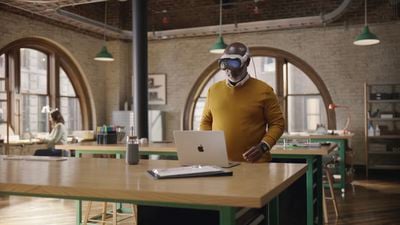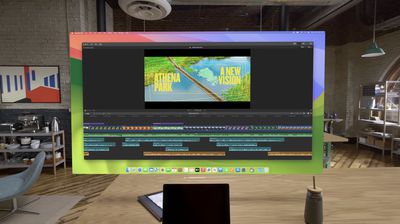When Apple first unveiled its next-generation Vision Pro headset at WWDC 2023, the company shared promotional videos that briefly teased the potential applications of using the $3,499 spatial computing device in conjunction with a Mac.

Now that Vision Pro has launched in the United States, we have a better idea of what it can do when bringing a Mac into your virtual workflow. Here's what we know.
Mac and Vision Pro: What You Can Do
Create a Virtual Desktop
When it comes to the Mac, the keystone feature of Apple Vision Pro is something called Mac Virtual Display. The system uses AirPlay 2, and allows you to connect your Mac wirelessly to the headset just by looking at your computer through your Vision Pro. This allows you to place and resize a virtual representation of your Mac's display anywhere in space, and use Vision Pro as an enormous 4K display. The feature is compatible with any Mac running macOS Sonoma, but if the Mac has an Intel processor, resolution is limited to up to 3K.
Use visionOS Apps Alongside Your Mac
With Mac Virtual Display enabled, you can use visionOS apps right alongside your virtual Mac screen. This will allow you to, for example, work on a Final Cut Pro project on an enormous Mac display while also viewing and interacting with separate screens displaying visionOS apps like Photos, Notes, Files, and so on.
Mirror Vision Pro to Mac
Apple Vision Pro supports screen mirroring via AirPlay or FaceTime. When wearing Vision Pro, you can select a Mac from the visionOS Control Center to mirror content from the headset ("Mirror My View"), allowing you to share your view with others and reduce any sense of isolation.
Connect Mac Accessories
Vision Pro includes a virtual keyboard for spatial computing sessions, but you can also wirelessly connect Mac accessories to the Vision Pro, including the Magic Keyboard and the Magic Trackpad for more traditional tactile input. Attaching Bluetooth accessories allows for a typical Mac workflow to continue to be used, just with the Mac display replaced by Vision Pro.
Mac and Vision Pro: What You Can't Do
Arrange Mac Apps in Virtual Space
Prior to Apple's official unveiling of Vision Pro, many Mac users envisioned an ideal multitasking scenario where it would be possible to break out Mac apps individually in a mixed reality workspace and switch attention between them at a glance. However, now we know that it is not possible to view individual Mac apps in virtual windows alongside one another in Vision Pro's spatial computing environment.
Create Multiple Virtual Displays
Another limitation of the first-generation Vision Pro is that it only supports mirroring your Mac's built-in display. In other words, it isn't currently possible to extend your Mac's screen or recreate a multiple monitor Mac setup in the mixed reality workspace. This could be due to bandwidth limitations (Mac Virtual Display outputs in 4K). On that basis, multiple Mac displays in Vision Pro's spatial computing environment may be something supported in a future version or with a future software update, but don't expect such functionality out of the box.
Connect a Bluetooth Mouse
Unfortunately, the Apple Vision Pro does not work with Bluetooth mice at all, even if it is one made by Apple. As mentioned above, Vision Pro does work with the Apple Magic Trackpad, but older Trackpads with removable batteries are not compatible, nor are trackpads from other manufacturers.
Apple Vision Pro and the Future of Mac
As the above suggests, Mac and Vision Pro interoperability remains fairly basic at the time of writing. However, there's good reason to be optimistic about the future of Mac in the era of spatial computing. This is just the first-generation version of Apple's headset. Expect more to come.

Apple Vision Pro went on sale in the U.S. on Friday, February 2, with availability in Canada and the United Kingdom expected to follow later in the year.























